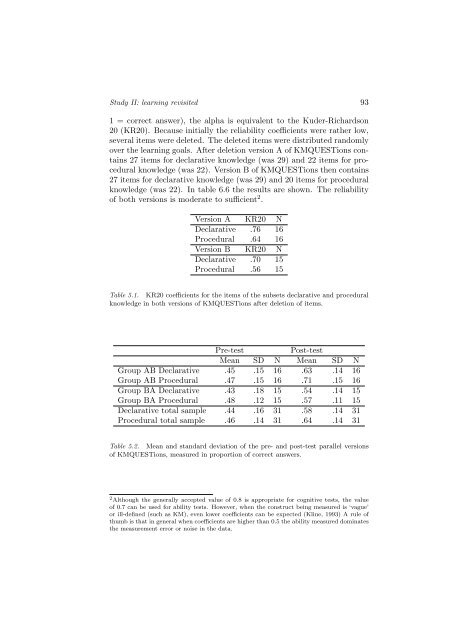The role of metacognitive skills in learning to solve problems
The role of metacognitive skills in learning to solve problems
The role of metacognitive skills in learning to solve problems
Create successful ePaper yourself
Turn your PDF publications into a flip-book with our unique Google optimized e-Paper software.
Study II: learn<strong>in</strong>g revisited 93<br />
1 = correct answer), the alpha is equivalent <strong>to</strong> the Kuder-Richardson<br />
20 (KR20). Because <strong>in</strong>itially the reliability coefficients were rather low,<br />
several items were deleted. <strong>The</strong> deleted items were distributed randomly<br />
over the learn<strong>in</strong>g goals. After deletion version A <strong>of</strong> KMQUESTions conta<strong>in</strong>s<br />
27 items for declarative knowledge (was 29) and 22 items for procedural<br />
knowledge (was 22). Version B <strong>of</strong> KMQUESTions then conta<strong>in</strong>s<br />
27 items for declarative knowledge (was 29) and 20 items for procedural<br />
knowledge (was 22). In table 6.6 the results are shown. <strong>The</strong> reliability<br />
<strong>of</strong> both versions is moderate <strong>to</strong> sufficient 2 .<br />
Version A KR20 N<br />
Declarative .76 16<br />
Procedural .64 16<br />
Version B KR20 N<br />
Declarative .70 15<br />
Procedural .56 15<br />
Table 5.1. KR20 coefficients for the items <strong>of</strong> the subsets declarative and procedural<br />
knowledge <strong>in</strong> both versions <strong>of</strong> KMQUESTions after deletion <strong>of</strong> items.<br />
Pre-test<br />
Post-test<br />
Mean SD N Mean SD N<br />
Group AB Declarative .45 .15 16 .63 .14 16<br />
Group AB Procedural .47 .15 16 .71 .15 16<br />
Group BA Declarative .43 .18 15 .54 .14 15<br />
Group BA Procedural .48 .12 15 .57 .11 15<br />
Declarative <strong>to</strong>tal sample .44 .16 31 .58 .14 31<br />
Procedural <strong>to</strong>tal sample .46 .14 31 .64 .14 31<br />
Table 5.2. Mean and standard deviation <strong>of</strong> the pre- and post-test parallel versions<br />
<strong>of</strong> KMQUESTions, measured <strong>in</strong> proportion <strong>of</strong> correct answers.<br />
2 Although the generally accepted value <strong>of</strong> 0.8 is appropriate for cognitive tests, the value<br />
<strong>of</strong> 0.7 can be used for ability tests. However, when the construct be<strong>in</strong>g measured is ‘vague’<br />
or ill-def<strong>in</strong>ed (such as KM), even lower coefficients can be expected (Kl<strong>in</strong>e, 1993) A rule <strong>of</strong><br />
thumb is that <strong>in</strong> general when coefficients are higher than 0.5 the ability measured dom<strong>in</strong>ates<br />
the measurement error or noise <strong>in</strong> the data.
















